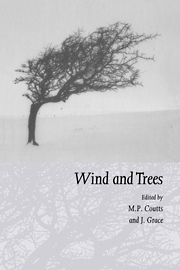Book contents
- Frontmatter
- Contents
- Preface
- List of contributors
- Part I Airflow over topography and in forests
- Part II Mechanics of trees under wind loading
- 7 Understanding wind forces on trees
- 8 Modelling mechanical stresses in living Sitka spruce stems
- 9 Experimental analysis and mechanical modelling of windinduced tree sways
- 10 Failure modes of trees and related failure criteria
- 11 An experimental investigation of the effects of dynamic loading on coniferous trees planted on wet mineral soils
- 12 Measurement of wind-induced tree-root stresses in New Zealand
- 13 New methods for the assessment of wood quality in standing trees
- Part III Tree physiological responses
- Part IV Impacts of wind on forests and ecology
- Part V Risk assessment and management response
- Index
8 - Modelling mechanical stresses in living Sitka spruce stems
Published online by Cambridge University Press: 27 October 2009
- Frontmatter
- Contents
- Preface
- List of contributors
- Part I Airflow over topography and in forests
- Part II Mechanics of trees under wind loading
- 7 Understanding wind forces on trees
- 8 Modelling mechanical stresses in living Sitka spruce stems
- 9 Experimental analysis and mechanical modelling of windinduced tree sways
- 10 Failure modes of trees and related failure criteria
- 11 An experimental investigation of the effects of dynamic loading on coniferous trees planted on wet mineral soils
- 12 Measurement of wind-induced tree-root stresses in New Zealand
- 13 New methods for the assessment of wood quality in standing trees
- Part III Tree physiological responses
- Part IV Impacts of wind on forests and ecology
- Part V Risk assessment and management response
- Index
Summary
Abstract
Mathematical models of the transfer of wind momentum into forest canopies and the subsequent bending stresses in individual tree stems are presented. The windspeed profiles within and above canopies are predicted for conditions where the extreme windspeed likely to occur in a 50 year period in south-west Scotland is used as a reference. The stresses predicted by the models in these conditions are compared for Sitka spruce (Picea sitchensis (Bong.) Carr.) growing in an unthinned stand (3800 stems ha−1) and in a stand recently thinned by removing half the trees. The mechanical model of the trees includes the responses to dynamic as well as static bending forces. The calculated variation of stress along the stems of six trees of different dimensions is compared and found to have a maximum near the stem base in some trees but a nearly constant pattern for several metres in other trees. The maximum value of stress is about 10 MPa for trees in the unthinned model and about 20 MPa for the recently thinned model. These stresses are compared with the estimates from published studies of the strengths of the root systems and of the stem wood. The increases in stress with thinning are shown to reflect qualitative observations in British plantations that wind damage is more likely and that this will be in the form of overturning rather than stem snap. It is concluded that the models should be a good basis for further work on estimating the risk of wind damage to plantation trees.
- Type
- Chapter
- Information
- Wind and Trees , pp. 165 - 181Publisher: Cambridge University PressPrint publication year: 1995
- 10
- Cited by



